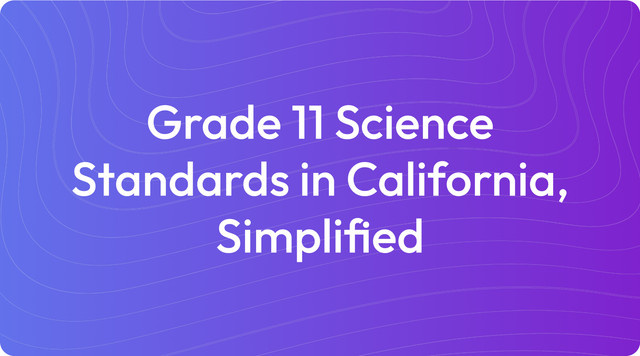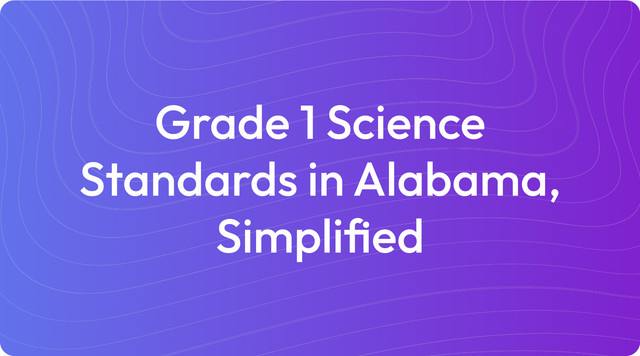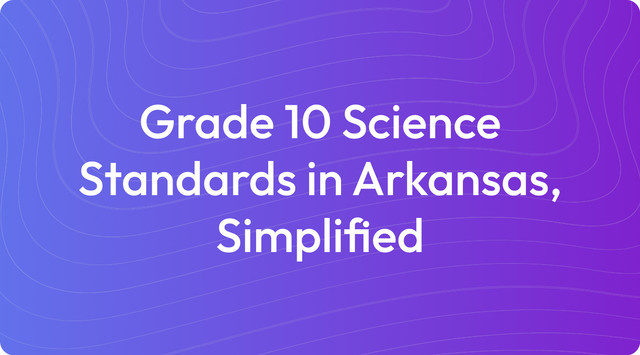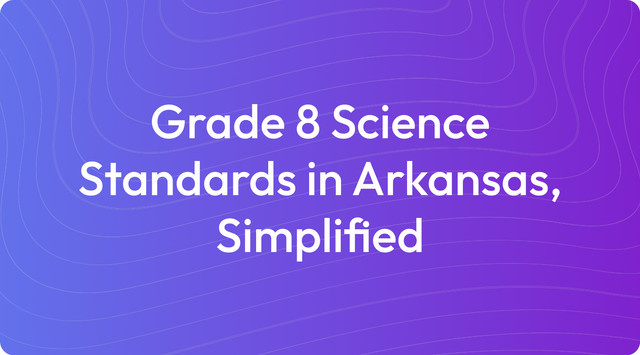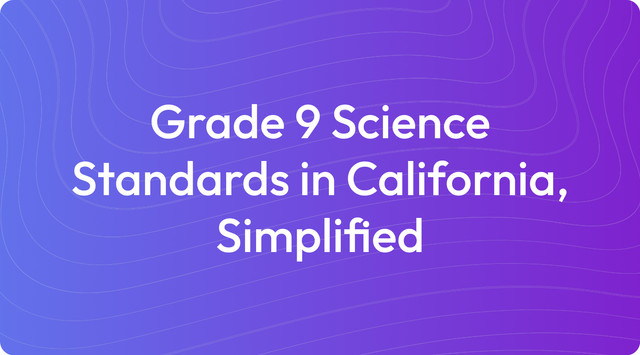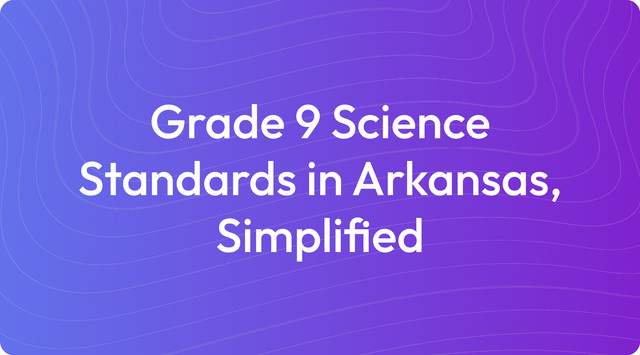Grade 9 Science Standards in Alaska, Simplified
Grade 9 science in Alaska examines physical and life sciences, energy, heredity, and Earth systems. For a snapshot, read more on TeachShare!
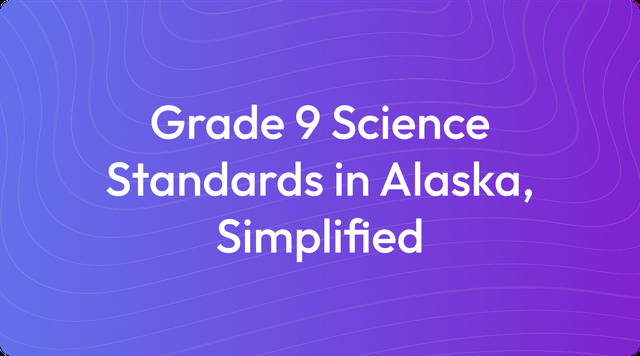
We understand that planning your curriculum requires careful thought and a clear view of learning objectives. Finding the right resources to align with state requirements can be a significant part of that work. Our goal is to provide tools that help you connect your lesson plans to these foundational standards.
Education standards are learning goals that outline what students are expected to know and be able to do at each grade level. For teachers, they provide a framework for instruction without dictating specific teaching methods. For example, the Grade 9 Science Standards in Alaska specify that students should be able to use the periodic table to predict element properties, but leave the choice of activity to the educator.
What Are Grade 9 Science Standards in Alaska?
The Grade 9 Science Standards for Alaska are built upon the Next Generation Science Standards (NGSS) and are organized into four main areas of study. These standards focus on developing a deep understanding of core scientific concepts through hands-on learning and real-world problem-solving. Here is an outline of the core standards for Grade 9 science:
1. Physical Science (PS): Matter, Energy, and Forces
- Standard HS-PS1-1: Use the periodic table as a model to predict the relative properties of elements based on patterns of electrons in the outermost energy level.
- Standard HS-PS1-2: Construct and revise an explanation for the outcome of a chemical reaction based on the properties of atoms and the conservation of matter.
- Standard HS-PS3-1: Create a computational model to calculate the change in energy of a system when objects interact.
- Standard HS-PS4-1: Use mathematical representations to support a claim regarding relationships among wavelength, frequency, and energy of waves in the electromagnetic spectrum.
2. Life Science (LS): Ecosystems, Genetics, and Cells
- Standard HS-LS1-1: Construct an explanation based on evidence for how the structure of DNA determines the structure of proteins, which carry out the essential functions of life.
- Standard HS-LS2-4: Use mathematical representations to support claims for how energy and matter cycle through ecosystems.
- Standard HS-LS3-1: Ask questions to clarify relationships about the role of DNA and chromosomes in coding the instructions for traits passed from parents to offspring.
- Standard HS-LS4-4: Construct an explanation based on evidence for how natural selection leads to adaptation of populations.
3. Earth and Space Science (ESS): Earth's Processes and Human Impact
- Standard HS-ESS1-1: Develop a model to explain the processes of star formation, nuclear fusion, and energy release in stars.
- Standard HS-ESS2-2: Analyze geoscience data to make claims about the role of water in Earth’s surface processes.
- Standard HS-ESS3-1: Construct an explanation based on evidence for how natural resources, climate change, and human activity impact Earth’s systems.
4. Engineering Design (ETS): Problem-Solving
- Standard HS-ETS1-1: Analyze a major global challenge to specify qualitative and quantitative criteria and constraints for solutions that account for societal needs and wants.
- Standard HS-ETS1-3: Evaluate a solution to a real-world problem based on prioritized criteria and trade-offs that account for cost, safety, and environmental impact.
The framework for these standards is guided by the Science Standards for Alaska, which are adapted from the Next Generation Science Standards. Our goal is to provide clear resources to help you align your curriculum with these important learning objectives.
Key Tested Standards
The Alaska Science Assessment measures a student's ability to apply scientific knowledge in practical ways. The key tested standards focus on advanced concepts in Physical Science, Life Science, Earth and Space Science, and Engineering Design, assessing how students analyze data, construct explanations, use models, and solve real-world problems.
Key Tested Standards for Grade 9 Science in Alaska
1. Physical Science (PS): Matter, Energy, and Waves
- Standard HS-PS1-1: Use the periodic table as a model to predict the properties of elements based on their atomic structure.
Why It’s Key: This builds a foundational understanding of periodic table patterns and the connection between atomic structure and element properties. - Standard HS-PS1-2: Construct an explanation for the outcomes of chemical reactions based on the properties of atoms and conservation of matter.
Why It’s Key: This standard introduces the principles of balancing chemical equations and the conservation of matter during reactions. - Standard HS-PS3-1: Create a computational model to calculate the change in energy of a system during object interactions.
Why It’s Key: It helps students grasp the concept of energy transfer within physical systems, like in collisions or thermal processes. - Standard HS-PS4-1: Use mathematical representations to describe relationships between wavelength, frequency, and energy of waves.
Why It’s Key: This standard clarifies the relationship between wave properties and energy, which is fundamental to understanding light, sound, and related technologies.
2. Life Science (LS): Genetics, Biodiversity, and Ecosystems
- Standard HS-LS1-1: Explain how DNA structure determines protein function and supports essential life processes.
Why It’s Key: It explains how genetic information is translated into the proteins that carry out the functions of living things. - Standard HS-LS2-4: Use mathematical representations to support claims about how energy and matter cycle through ecosystems.
Why It’s Key: This helps students see how energy moves through different trophic levels and how matter is cycled within ecosystems. - Standard HS-LS4-4: Construct an explanation based on evidence for how natural selection leads to population adaptations.
Why It’s Key: It explains the role of genetic traits in survival, reproduction, and the adaptation of populations to changing environments.
3. Earth and Space Science (ESS): Earth’s Systems and Human Impacts
- Standard HS-ESS2-2: Analyze geoscience data to explain how water impacts Earth’s surface processes.
Why It’s Key: This standard shows how water is a powerful agent in shaping landscapes through processes like erosion, deposition, and glacial activity. - Standard HS-ESS3-1: Construct an explanation for how natural resources, human activity, and climate change impact Earth’s systems.
Why It’s Key: It builds awareness of human effects on the environment, covering topics like resource management and sustainability. - Standard HS-ESS3-4: Evaluate or refine technological solutions that reduce human impact on natural systems.
Why It’s Key: This encourages students to think about and refine technological solutions that lessen human impact on natural systems.
4. Engineering Design (ETS): Problem-Solving
- Standard HS-ETS1-1: Analyze global challenges to define criteria and constraints for solutions.
Why It’s Key: It prompts students to approach major global challenges by defining clear criteria and constraints for potential solutions. - Standard HS-ETS1-2: Design a solution to a real-world problem by breaking it down into smaller problems that can be solved through engineering.
Why It’s Key: This standard focuses on breaking down complex, real-world problems into smaller, manageable parts that can be addressed through engineering. - Standard HS-ETS1-3: Evaluate solutions to real-world problems based on criteria and constraints, including cost, safety, reliability, and environmental impact.
Why It’s Key: It teaches students to critically assess solutions by weighing trade-offs among factors like cost, safety, and environmental effects.
Why These Standards Are Key for Testing
These standards are selected to assess a student's ability to think and work like a scientist. The focus is on practical application rather than just memorization. Assessments built around these standards will measure how well students can:
- Analyze and Interpret Data: For example, interpreting wave properties, calculating energy transfer, or studying ecosystem energy flow.
- Construct Explanations with Evidence: For example, explaining chemical reactions, DNA’s role in protein synthesis, or natural selection.
- Use Models: For example, modeling DNA, the water cycle, or Earth’s systems.
- Solve Real-World Problems: For example, designing sustainable solutions for environmental challenges or renewable energy.
The key tested standards are adapted from the Science Standards for Alaska and the Next Generation Science Standards.
Example Learning Objectives for Unit Planning
Learning objectives are clear, specific statements that describe what students should know or be able to do by the end of a lesson or unit. They act as a roadmap for both teaching and assessment, ensuring that instruction is focused and student progress is measurable. To help with your curriculum planning, we've outlined some sample objectives for the Grade 9 Science Standards in Alaska, written in student-friendly "I can" statements.
Physical Science (PS): Matter, Energy, and Waves
Here are some objectives for Physical Science:
- I can use the periodic table to predict how elements behave based on their atomic structure.
- I can balance chemical equations and explain how matter is conserved in chemical reactions.
- I can calculate changes in energy when objects interact, like during collisions or heat transfer.
- I can describe the relationship between wavelength, frequency, and energy for waves like light or sound.
Life Science (LS): Ecosystems, Genetics, and Adaptation
Objectives for Life Science include:
- I can explain how the structure of DNA determines how proteins are made and how they function in living things.
- I can use math to show how energy flows through trophic levels in an ecosystem, like in a tundra or marine food web.
- I can explain how natural selection leads to adaptations that help populations survive in their environments.
- I can investigate how environmental and genetic factors, like water availability or inherited traits, influence the growth of plants and animals.
Earth and Space Science (ESS): Earth’s Systems and Human Impact
For Earth and Space Science, students can aim to:
- I can describe how water shapes Earth’s surface through processes like erosion, glacial movement, and deposition.
- I can use evidence to explain how human activities, like burning fossil fuels, contribute to climate change.
- I can propose solutions to minimize human impact on Earth’s systems, like creating renewable energy options or managing natural resources sustainably.
- I can model how Earth’s systems (geosphere, hydrosphere, biosphere, atmosphere) interact, like in the water cycle or climate systems.
Engineering Design (ETS): Problem-Solving
In Engineering Design, key learning objectives are:
- I can analyze a global problem, like access to clean water or renewable energy, and identify criteria and constraints for solving it.
- I can design and test a solution to a real-world problem, like building a water filtration system or a wind turbine.
- I can evaluate multiple solutions to a problem and choose the best one based on factors like cost, safety, and environmental impact.
- I can improve my design by testing it, identifying weaknesses, and making changes to make it more effective.
Key Changes & Updates
The recent updates to the Grade 9 Science Standards in Alaska represent a significant shift toward more dynamic, inquiry-based learning. The new framework places a strong emphasis on hands-on investigation, encouraging students to actively explore scientific concepts through labs, experiments, and modeling. A key change is the full integration of engineering design practices, which prompts students to define real-world problems, design and test solutions, and refine their work. This approach helps build practical problem-solving skills and prepares students for future opportunities by focusing on active participation rather than passive learning.
Alongside these pedagogical shifts, the standards introduce a stronger focus on specific content areas, including energy transfer, genetics, and the mechanisms of adaptation. What makes these updates particularly relevant is their direct connection to Alaska’s unique environment. The curriculum now incorporates local examples, from the impact of glaciers on the landscape to the study of tundra ecosystems and the challenges of permafrost melt. By asking students to analyze data on climate change and propose sustainable solutions for local communities, the standards make science both meaningful and immediately applicable, reinforcing essential math and literacy skills along the way.
Create with TeachShare
We understand that adapting to updated standards while creating engaging lessons is a significant part of your work. Our platform is designed to help you build high-quality, standards-aligned materials quickly, giving you more time to focus on what you do best—teaching your students. Start creating standards-aligned instructional resources with TeachShare now.
Frequently Asked Questions
How can I connect Grade 9 science lessons to our local Alaskan context?
The standards are designed to be deeply rooted in Alaska’s unique environment, making science more tangible for your students. You can ground your lessons in local examples and challenges. Here are a few ideas:
- Explore how Alaska’s landscapes are shaped by geologic processes like volcanic activity, glaciers, and erosion.
- Investigate the distinct flow of energy through local ecosystems such as tundra, boreal forests, and marine environments.
- Analyze the real-world effects of climate change on Alaska, including permafrost melt and rising sea levels.
- Examine sustainable resource management issues that are critical to our state, like fisheries and renewable energy solutions.
What kind of project-based learning can I implement for Grade 9 science?
The curriculum’s focus on engineering design is perfect for project-based learning. These projects guide students through the process of identifying a problem, creating a solution, and refining their work based on testing. For example, you could have students design and build prototypes for:
- Water filtration systems to address a hypothetical community need.
- Renewable energy devices, such as small-scale wind turbines.
- Solutions to reduce human impact on a local ecosystem.
How do the standards balance theoretical knowledge with practical skills?
The standards create a strong connection between foundational concepts and their real-world application. On one hand, students build a solid base of knowledge in core areas like atomic structure, genetics, and Earth’s systems, which prepares them for more advanced high school science courses. On the other hand, they are constantly asked to apply this knowledge through hands-on activities, data analysis, and engineering projects. This approach ensures students not only know the science but can also use it to think critically and solve problems.
What are some strategies for assessing student understanding beyond traditional tests?
The standards encourage a variety of assessment methods that give you a fuller picture of student learning. Instead of relying solely on tests, you can evaluate understanding through performance-based tasks. Here are some effective strategies:
- Investigations: Observe students as they conduct experiments, such as identifying evidence of a chemical reaction or testing energy transfer.
- Models: Ask students to create physical or digital models to explain complex concepts like DNA replication or food webs.
- Data Analysis: Assess how students interpret and draw conclusions from data sets, like charts showing greenhouse gas trends or population changes.
- Design Projects: Evaluate students on their ability to design, test, and improve a solution to a given problem.
How does the Grade 9 curriculum foster environmental stewardship in students?
Environmental awareness is woven throughout the curriculum by focusing on the relationship between humans and the natural world. The standards help students become responsible stewards by teaching them to:
- Understand how energy and matter cycle through ecosystems and how human activities can disrupt these systems.
- Analyze scientific data on climate change to understand its causes and effects on a global and local scale.
- Design practical solutions to environmental challenges, encouraging them to think critically about resource conservation and renewable energy.
Answer


